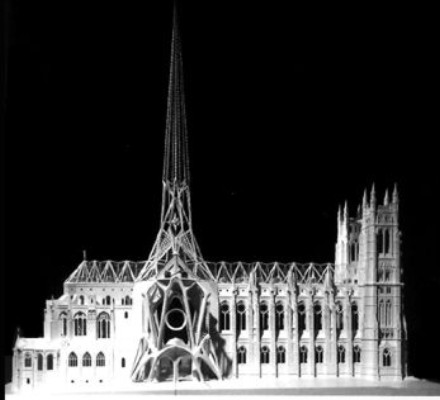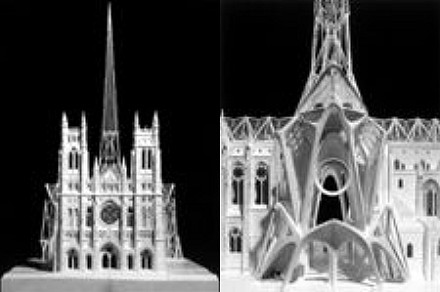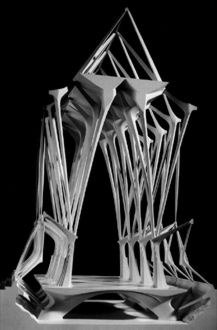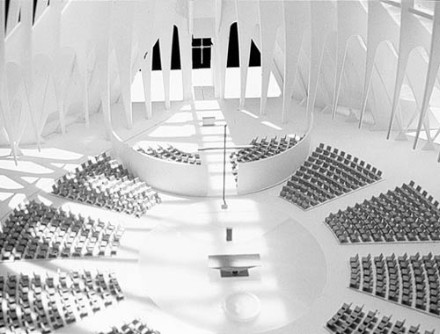
About Andrew Cusack
 Writer, web designer, etc.; born in New York; educated in Argentina, Scotland, and South Africa; now based in London.
Writer, web designer, etc.; born in New York; educated in Argentina, Scotland, and South Africa; now based in London. read more
News
Blogs
Reviews & Periodicals
Arts & Design
World
France
Mitteleuropa
Knickerbockers
Argentina
The Levant
Africa
Cape of Good Hope
Netherlands
Scandinavia
Québec
India
Muscovy
Germany
Academica
Calatrava’s St. John the Divine

I’ve always somewhat admired Santiago Calatrava’s plan for the completion of the (Episcopalian) Cathedral of St. John the Divine here in New York. It was commissioned in the 1980’s by the über-dodgy Rev. James Parks Morton, dean of the Cathedral at the time. Morton was responsible for turning “St. John the Unfinished” into the hippie-trippy-ecumenical-syncretist-pagan-temple-cum-performing-arts-center it is known as today, and came up with this scheme to try to bring the cathedral to completion. (The plan has since been abandoned and all construction ceased a decade ago; scaffolding remains because the cost of removing it was judged to be too high).

 The plan involved a ‘biosphere’ garden being planted atop the nave in the giant greenhouse formed by Calatrava’s lithely arches. Though I much prefer the crossing tower in the design by Ralph Adams Cram, I still think that Calatrava’s plan is rather exciting. It only succeeds, however, because Cram and (Heins & Lafarge before him) laid an ample beautiful foundation (well, obviously quite much more than that) for Calatrava to complete. The cathedrals which Signor Calatrava has designed completely himself have been completey devoid of aesthetic appeal, as well as conceived outside of the millenia-long tradition of church architecture.
The plan involved a ‘biosphere’ garden being planted atop the nave in the giant greenhouse formed by Calatrava’s lithely arches. Though I much prefer the crossing tower in the design by Ralph Adams Cram, I still think that Calatrava’s plan is rather exciting. It only succeeds, however, because Cram and (Heins & Lafarge before him) laid an ample beautiful foundation (well, obviously quite much more than that) for Calatrava to complete. The cathedrals which Signor Calatrava has designed completely himself have been completey devoid of aesthetic appeal, as well as conceived outside of the millenia-long tradition of church architecture.
The (Catholic) Diocese of Oakland commissioned Calatrava to design their new ‘Cathedral of Christ the Light’ after the old seat was greatly damaged in an earthquake. Despite the vacuousness of the design (model below), Signor Calatrava proved to be outside the Diocese’s budget, and his second-rate design was shelved and replaced with a third-rate design of a vaguely similar ilk. The third-rate design is the one which will be built, though a first-rate proposal in the vernacular style natural to California has been drawn up by Mr. Domiane Forte. Methinks Signor Calatrava should stick to his catchy bridges.

Search
Instagram: @andcusack
Click here for my Instagram photos.Most Recent Posts
- Teutonic Takeover March 10, 2025
- Katalin Bánffy-Jelen, R.I.P. March 3, 2025
- Substack Cusackiensis March 3, 2025
- In the Courts of the Lord February 13, 2025
- American Exuberant February 10, 2025
Most Recent Comments
Book Wishlist
Monthly Archives
Categories



Hello Andrew,
I really appreciate your dedicated site, its very refreshing. I would just like to comment on this fascinating piece of architecture. I, personally, very much like Calatrava’s addition to the cathedral. Yes, of course, its not exactly done in the same style, but at the same time I don’t feel that the two styles necessarily conflict. I’ve always liked, as do you, classical (New Yorker, renaissance or “cathedral”) architecture because I feel as though it is solid, rooted, stately, balanced and generally quite pleasing to the eye (as, I must say with regret, unlike some modern architecture). When I look at Calatrava’s piece, I see many of the same qualities except the difference being his use of nonlinear and more natural lines and forms. Therefore, I feel like the styles work together quite well. In fact, i have always enjoyed when classical style meets modern styles because it seems as though, like you observed, the classical style ties the entire structure down and provides a good foundation for the modern. As for the episcopalian church, it seems to me like they need a little more of this unorthodox architecture- it would liven things up.
Unfortunately I don’t take such a positive view of the proposed design – the Sagrada Familia “inspiration” seems far too blatent. But then, this church has never had an ideal design for the central tower, the designs have all been too self-consciously “great”, but failing to achieve that aim by quite some margin. A simple fleche could complete it until the funds arrive for something more ideal (which will not happen in the near future anyway).
As an Episcopalian and someone who has been to the Cathedral many times, I have to agree with SV that the principal reason the Cathedral is not finished is because too many of the proposed designs have been overly grandiose. Although it may not be “exciting” to fans of modern architecture, I think the best way to finish St. John’s is to stick to the Gothic architecture of the Nave and just fill in the unfinished Crossing while retaining the tiled dome. Perhaps the Dome could be livened up a bit with some artwork. Personally I find that Churches built in a modern Architectural style are often cold and anachronistic. Case in point, is the Catholic dioceses of San Francisco and Oakland, both of which have cold uber-modern Cathedrals which succeed only in feeling like airport terminals. Churches should be about creating a sacred atmosphere that taps into the collective subconscious – bright light, steel and concrete don’t really work well in achieving this.
You must have meant señor Calatrava, not signor.
Where is presbiterium? Why the cross is without Jesus? What abut Tabernaculum? Minimalism is not catolic style, havens are not “minimalistic”…
You keep calling him ‘Signor’ Calatrava. Look, the guy is not Italian, he’s Spanish.
Don’t let Macron see this!